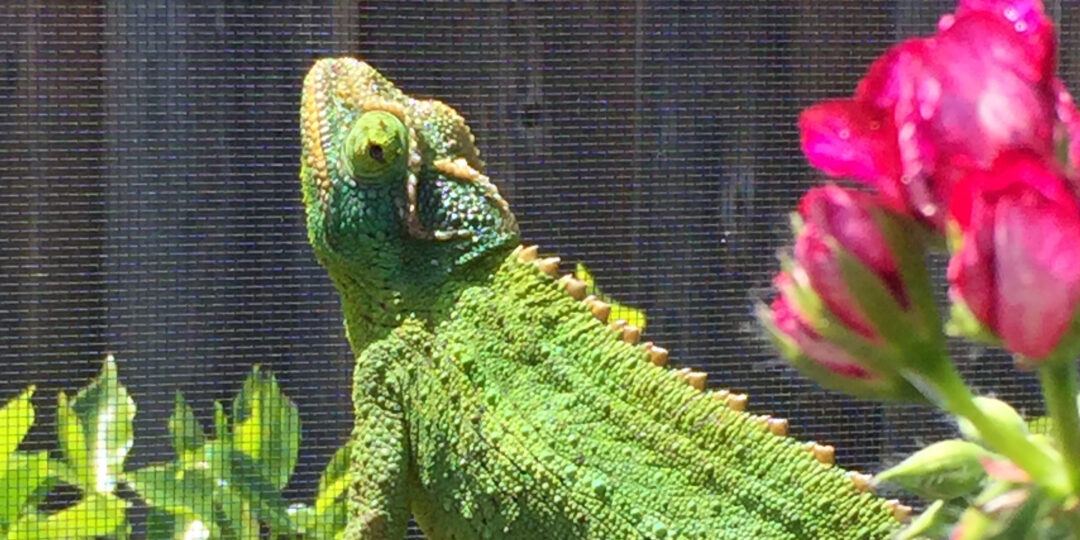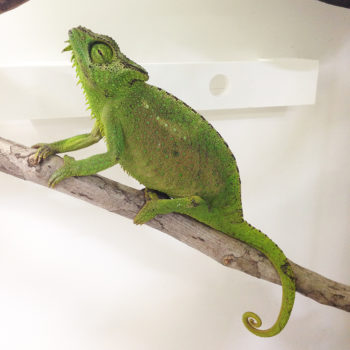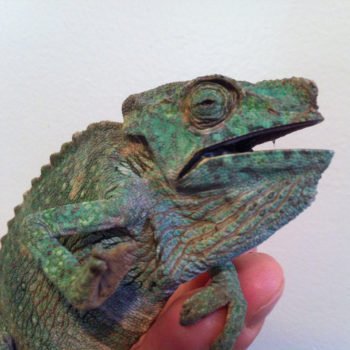Respiratory Infection
Description
A respiratory infection is a bacterial infection which has taken hold in the lungs of the chameleons. As the infection grows, the ability of the lungs to absorb oxygen is decreased and the chameleon will struggle to get oxygen more and more to the point of death.
This is often called an Upper Respiratory Infection or URI. This is not entirely accurate as chameleons don’t have enough of a respiratory system to have an upper and lower respiratory system. The URI term persists. But be aware that it is the same as saying a “respiratory infection”.
As the lungs breathe in bacteria with every breath it is the immune system’s job to fight these invaders off. Thus it is imperative to have a strong immune system. Stress and subpar husbandry conditions will weaken the immune system. The good news is that providing proper husbandry will prevent 99% of respiratory infections.
Symptoms
When an infection takes hold in the lungs it will decrease the ability of the lungs to absorb oxygen which means the chameleon will have to work harder. Having to work harder to breathe combined with the existing stress on the immune system adds to the downward spiral.
The first external signs of a respiratory infection are the chameleon sticking its nose in the air. This is to straighten out the trachea to ease in getting air in the lungs. The condition will progress to open mouth breathing. At any point in this process you will notice that they will start to close their eyes as an indication of their internal distress. At the beginning you will catch them with mouth open and/or eyes closed and they will quickly notice your presence and close their mouth/open their eyes. This is the natural impulse to give a show of being healthy. But this is not the time to question what you saw. This is the time to act as the next step is for the condition to be so bad that the chameleon looses the will to even pretend to be healthy.
The chances of recovery are directly related to when the treatment starts. By time the chameleon sticks its nose in the air, the infection is well under way. There is no other reason for a chameleon to sit on a branch with its nose in the air so do not wait until the symptoms become unmistakeable. Get to the vet as soon as possible and get antibiotic treatment started. This is not overreacting. It is the perfect reaction and it may be what saves your chameleon’s life. Bacterial infections caught early are able to be beaten. If treatment is started late the chances are diminished.
This female Trioceros jacksonii xantholophus is showing the initial symptoms of respiratory infection. She has her nose in the air. Her eyes are not sunken in and she is not open mouth breathing. She is active and casually switches to her head down when I won’t leave the area. At this point I treated her with a complete change in husbandry which included a much larger, heavily planted, outdoor cage in natural sunlight. Normally, this is the perfect time to go to the vet and get antibiotics to knock the infection out. My deep experience with this species gave me confidence that this husbandry change was all that was needed. I was correct and she made a full recovery. But I assure you that if she did not show signs of improvement and showed any sign of the infection progressing I would be immediately sitting in the vets office for antibiotics.
This female Trioceros deremensis was gaping with her nose in the air when I walked in the room.
Get your chameleon to the vet at the first sign of them with their nose in the air during a resting position. The sunken eyes and reluctance to close her mouth are both signs that this is in the middle stages of infection heading quickly towards advanced stages.
The above female Trioceros deremensis had an infection that was far enough along that my presence was not enough for her to revert back to pretending she was healthy. I was able to get a picture of her gaping. The presence of the mortal enemy of all chameleon – the camera – though was threatening enough that she quickly closed her mouth to give as much of a show of health as possible.
The sunken eyes and reluctance to close her mouth are both signs that this is in the middle stages of infection heading quickly towards advanced stages. Do not fall into the trap thinking that if you disturb them and they stop gaping or bring their nose down that you are overreacting and there is nothing to worry about. This is the stage of the infection where chances of recovery are high if antibiotics and husbandry correction are administered.
This Meller’s Chameleon showed all the classic signs of respiratory infection, but would not respond to antibiotic treatment. It is possible that the bacteria causing the infection did not respond to the broad spectrum Baytril or it could be that this was, in fact, a viral infection that exhibited the same symptoms as a respiratory infection.
Treatment
Treating a bacterial infection is always dual pronged. First, go see your veterinarian for antibiotics and, second, correct the condition which caused the weakened immune system to begin with.
Vet visit: A veterinarian is necessary for antibiotic treatment. Antibiotics are usually given in oral or injectable forms. The best way to go about treatment is to get the bacteria cultured and the correct antibiotic prescribed. Unfortunately, this may be difficult with the infection in the lungs. Usually, though, the vet will prescribe a “broad spectrum” antibiotic that has a history of being effective with the most common strains. It is critical to follow through the entire antibiotic course even if improvement has been shown in order to reduce the chances of producing antibiotic resistant bacteria.
Investigation of Cause: The second part of treating an infection is to correct the cause. If the cause is not addressed then the infection will return. If the compromised immunity that allowed the bacteria to take hold was because of a substandard husbandry condition, that condition must be corrected.
Bacterial infections have a great chance of recovery if they are caught early. The more advanced the infection the harder it is to beat it back.
Husbandry Correction
The most common husbandry conditions which will cause decreased immunity are the cage too hot or cold, or constant stress due to insecurity. Cohabitation is a common cause of stress.








